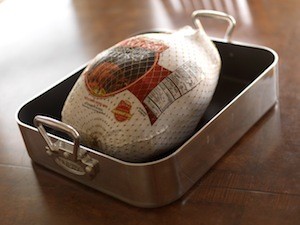Thaw your Thanksgiving turkey safely to have healthy holiday meals
BOONE COUNTY – The holiday season is right around the corner. Friends and family will soon be gathering around dinner tables across the nation to celebrate Thanksgiving during which many will be enjoying the traditional turkey Thanksgiving dinner.
According to the U.S. Census Bureau, Minnesota is ranked first in U.S. turkey production, producing 40 million turkeys in 2015.
Of course, that is only a portion of the 228 million turkeys raised annually in our country, but still serves as a strong indicator that turkey remains a favorite Thanksgiving Day staple.
Many who are new to cooking turkeys often have many questions and may or may not know where to turn for sound advice on preparing their holiday birds. With the advent of the internet, many will simply “Google” a recipe.
However, it is important to know there are important steps to consider before you are able to cook your turkey. The first step is thawing, which due to the large size of most turkeys, can take a long time.
Safely thawing your holiday turkey
When it comes to thawing your turkey, the key is to plan ahead.
“Turkey must thaw safely because once it begins to thaw, any bacteria that may have be present before freezing can begin to grow and multiply,” Diane Reinhold, University of Illinois Nutrition and Wellness Educator and registered dietitian, said.
According the United States Department of Agriculture (USDA) Food Safety and Inspection Services, refrigerator thawing, cold water thawing, and microwave thawing are the recommended practices when it comes to safely thawing your holiday turkey.
Thawing turkey in refrigerator
When thawing your turkey in the refrigerator you should allow approximately 24 hours for each four to five pounds of turkey, and the turkey should be thawed in a refrigerator set at 40 degrees Fahrenheit or below.
If your whole turkey weighs between four to 12 pounds, you should plan on allowing your turkey to thaw between one to three days. If you have a larger turkey (20 to 24 pounds), you would need to plan to have your turkey thaw between five to six days.
Additionally, if you are using the refrigerator to thaw your turkey, make sure the bird remains in the original plastic wrapping and place it in a container on a bottom shelf to prevent juices from dripping onto other foods during the thawing process. Once your turkey has thawed using this method, the turkey can remain in the refrigerator for one to two days before cooking.
Cold water thawing
Another safe thawing practice would be cold water thawing. For this method, you should allow about 30 minutes per pound of turkey.
“This is a much faster thawing practice. However, it is a little more labor intensive as the water will need to be replaced every 30 minutes until the turkey is thawed; you must use cold water, not warm,” Reinhold said.
Therefore, if your whole turkey weighs between four to 12 pounds, you should plan on allowing your turkey to thaw between two to six hours. If you have a larger turkey, 20 to 24 pounds, you would need to plan to have your turkey thaw between 10 to 12 hours.
When thawing your turkey in this manner, the turkey must be in a leak-proof plastic bag.
“The reason for this is twofold; first this will help to prevent cross-contamination in the event any juices leak out during the thawing process. Secondly, this will prevent the turkey from absorbing water, which will result in a watery product that is undesirable,” Reinhold explained.
Once a turkey is thawed using this process, the turkey should be cooked immediately.
Microwave thawing is another safe method for thawing your holiday turkey. You will need to check the owner’s manual for the size of turkey that will fit in your microwave, the minutes per pound, and the power level to use for thawing process.
“Additionally, you will need to remove the outside plastic wrap, any metal object on or in the turkey, and the pouch sometimes found inside the cavity of the turkey,” Reinhold said.
The turkey will need to be placed on a microwave-safe dish to catch all juices that may leak during the thawing process, and loosely covered. When selecting the dish, make sure it will fit appropriately inside the microwave, allowing the food to automatically rotate as this will allow a more even thawing of the turkey. Pay close attention to the turkey during thawing as the edges of the turkey may become warm and slightly cooked while the inside remains frozen.
Once the turkey has been thawed, cook the turkey immediately. Do not refreeze or refrigerate your turkey after thawing using the microwave thawing process.
Regardless of what method of thawing you decide to use, understand that following safe food handling practices is key to ensuring everyone gets through the holidays healthy and happy.
For more information on turkey safety, check out the University of Illinois Extension’s website, Turkey for the Holidays at http://extension.illinois.edu/turkey/turkey_safety.cfm.
Another great resource is the USDA Meat and Poultry Hotline, 1-888-MPHotline ((888) 674-6854). This hotline is available Monday through Friday from 9 a.m. to 3 p.m. and is available in either English or Spanish. Staff can personally answer your food safety questions regarding safe storage, handling, and preparation of meat, poultry, and egg products.
For more information about nutrition, wellnesses, and safe food handling, contact Diane Reinhold at (815) 235-4125 or [email protected].




